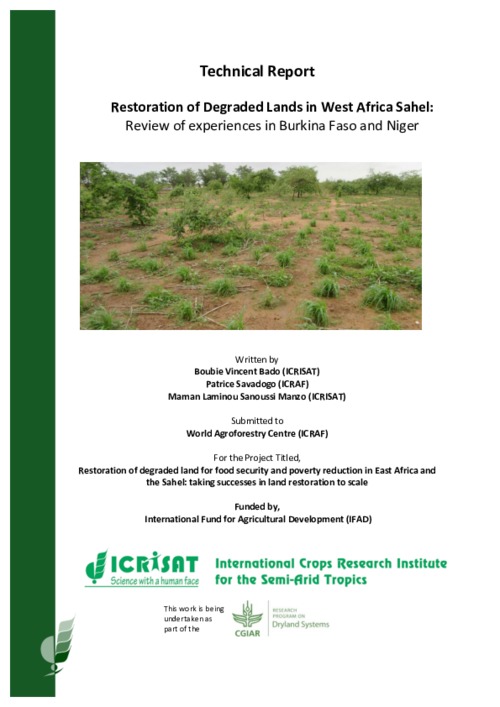Resource information
This is a comprehensive literature review of land restoration activities in West Africa Sahel.
Water constraints and the inherent soil poverty are the major factors that limit crop yields and productivity of cropping systems in West Africa Sahel (WAS). Livestock is not well integrated with agricultural activities and crop residues are usually exported from the farm for household needs and animal feeding. In traditional systems, soil fertility maintenance was based on a relatively long fallow period (10-15 years) followed by a short cropping period of 3 to 5 years. But the increased population pressure has resulted in significant changes of the traditional bushfallow system. Lands are now continuously cultivated for long period with low external inputs, leading to soil fertility decline over time (Bationo and Mokwunye 1991; Bekunda et al. 2010). In addition to biophysical aspects, a wide range of socio-economic factors such as the low financial capacities of poor farmers to invest in agricultural inputs, high pressure on ecological resources for food, fodder or energy, also add to the stress on the systems. Failure by the smallholder farmers to intensify agricultural production in a manner that maintains soil productivity is the main cause of land degradation, particularly in the fragile ecosystems of WAS. Land degradation is defined as a process that leads to the reduction of land productivity for useful purposes, and is typically a result of soil, wind, or water erosion; soil salinization; waterlogging; chemical deterioration; or any combination of these factors (Adeel 2003). Land degradation is a global problem, particularly in the dry areas, home to a large population of poor farmers, where land degradation and water scarcity are major threats to food security. The impacts of land degradation are severe on both human society and ecosystems. Desertification is often wrongly attributed solely to droughts, but it is the deadly combination of continued land abuse during periods of deficient rainfall that results in unproductive land, and ultimately desertification (UNESCO 2003). Combating desertification by rehabilitating degraded lands can be done successfully, using existing, often traditional techniques.
Land restoration involves restoring the fertility of degraded lands. The social syndrome where diminishing availability of lands, inherent low fertility, continuous soil erosion, and continuous nutrient removal without replenishment, results in a spiraling downfall in productive capacity and a diminished resilience of the soil system to provide a suitable medium for crop growth needs to be addressed. Smallholder farmers are at the center of both soil fertility decline and restoration process. Their decisions to manage, to utilize technologies and to improve or restore soil fertility are guided by the socioeconomic conditions and the overall benefits that will accrue from production (Sanginga and Woomer, 2009; Bekunda et al. 2010). A sustainable management of lands under cultivation and the restoration of degraded lands could be achieved by affordable strategic management innovations; taking into account the socioeconomic conditions of farmers. While individual technologies can contribute; a more integrated systems that combines technologies, crops, and trees such as the agroforestry systems could better contribute for sustainable management of natural resources. Many efforts have been invested to developing strategies and approaches for both sustainable management of natural resources and restoration of degraded lands in WAS. In some cases, farmer communities have developed sound, sustainable approaches to land rehabilitation and management but there is insufficient information on successful restoration in the context of WAS, particular with regards to policy, institutions and socioeconomic conditions under which specific approaches could be adapted and applied successfully (Bunning 2003). The main objective of this review was to investigate the main experiences of regenerating degraded landscapes (RDL) in Niger. Going through the documentation, we found many similarities in experiences across the two countries of Niger and Burkina. Some interesting experiences were found in Burkina, Niger or at the same time in the two countries. We finally decided to extend the review to the two countries as a representative zone of the WAS. The critical issue in taking restoration to scale is that ecological, economic and institutional context varies at fine scales. The main goal of this review is to identify the specificities and the context of the most efficient experiences of RDL that could be widely scaled in the WAS.


